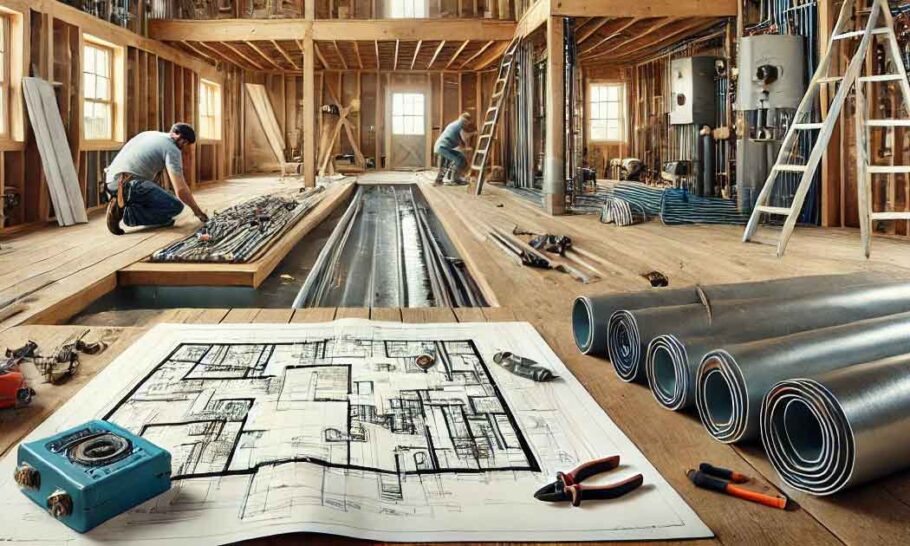When planning or living in a barndominium, water drainage might not be the first thing on your mind. After all, barndominiums are known for their durability, open-concept interiors, and affordability—not their plumbing. But when it comes to long-term structural integrity and livability, effective water drainage is one of the most critical elements of your barndominium’s design and maintenance strategy.
Whether you’re building from the ground up or improving an existing structure, understanding water drainage systems—both inside and out—can save you thousands in future repairs and make your home more comfortable, functional, and efficient.
Why Water Drainage Matters for Barndominiums
Barndominiums are typically metal buildings either converted into homes or built from scratch with steel framing and siding. While their construction lends itself to energy efficiency and longevity, poor drainage can lead to:
- Foundation erosion or settling
- Interior flooding or moisture damage
- Mold and mildew buildup
- Roof and siding damage
- Landscaping deterioration
A barndominium’s resilience is only as good as its drainage plan. Let’s explore how to design or improve water drainage systems to protect your investment.
1. Site Preparation and Grading
The First Line of Defense
Before any concrete is poured or posts are set, your site needs to be graded correctly. The goal is simple: get water away from your structure.
- Slope Away from the Building: Ensure the soil is graded to slope away from the barndominium at a minimum of 5% (about 6 inches over the first 10 feet).
- Avoid Low-Lying Areas: Building in valleys or depressions invites pooling and runoff toward your foundation.
- Use Retaining Walls or Berms: In sloped areas, build retaining walls or land berms to redirect water flow.
Even a perfectly designed drainage system will struggle if the ground surrounding your home encourages water accumulation.
2. Foundation Drainage Solutions
The foundation is the most vulnerable part of your barndominium to moisture damage. Here are ways to defend it:
Perimeter Drains (French Drains)
French drains—gravel-filled trenches with perforated pipes—are placed around the foundation to collect and redirect water.
- Where to Install: Around the base of the slab or piers
- Where to Redirect: Toward a dry well, storm sewer, or natural drainage channel
- Advantages: Prevents hydrostatic pressure from building around the foundation
Vapor Barriers and Slab Protection
For slab-on-grade barndominiums, a 6-mil or thicker polyethylene vapor barrier beneath the concrete prevents ground moisture from wicking into your home.
Combine this with insulating foam board or drainage mats under the slab for better protection in wet climates.
3. Gutter and Roof Drainage Systems
Barndominiums often feature large roof spans, which collect and shed significant amounts of water. Directing this runoff is essential to preventing erosion and foundation damage.
Gutters and Downspouts
- Material Choices: Aluminum, steel, copper (metal barndos match best with metal gutters)
- Gutter Size: For large roofs, opt for 6-inch gutters instead of standard 5-inch
- Downspout Placement: Every 20-30 feet of gutter length is typical, but this varies by rainfall intensity
- Splash Blocks or Downspout Extensions: These help spread water and move it away from the foundation
Rain Chains and Barrels
Want a decorative and eco-friendly solution? Rain chains and rain barrels can replace traditional downspouts to collect and reuse rainwater, perfect for irrigation.
4. Surface Drainage Strategies
Surface drainage helps move water across your property efficiently—especially during heavy rains.
Swales
A swale is a shallow, grassy ditch designed to carry water gently across a property. These are particularly useful in rural or semi-rural barndominium sites.
- Design Tip: Line swales with grass or gravel to reduce erosion
- Slope Requirement: A minimum slope of 2% (1/4 inch per foot) helps move water without causing damage
Driveway and Sidewalk Drainage
Paved surfaces should be angled to direct water away from the barndominium. If you’re pouring concrete for a long driveway, consider:
- Trench Drains: Slotted channels that collect surface water
- Gravel Shoulders: Allow runoff to soak into the ground instead of pooling
5. Subsurface Drainage Systems
In areas with heavy clay soil or high water tables, subsurface drainage helps prevent water from accumulating below the surface.
- Underdrains: Similar to French drains but buried deeper and used for fields, yards, and beneath driveways
- Dry Wells: Underground pits filled with gravel or perforated containers that hold and disperse runoff
These systems can work in tandem with gutters, downspouts, and perimeter drains.
6. Stormwater Management
If your barndominium is in a jurisdiction with stormwater regulations (common in urban and suburban developments), you may be required to manage runoff on-site.
Options include:
- Retention Ponds
- Infiltration Basins
- Bioswales
- Permeable Pavers
These systems slow water movement, reduce pollution, and help water absorb into the ground naturally rather than running off into storm drains.
7. Interior Drainage Considerations
Water drainage isn’t only about the outside. Inside, your plumbing system must be designed to handle wastewater efficiently.
Key Points:
- Slope All Drain Pipes Correctly: A minimum of 1/4 inch per foot for horizontal drains
- Install Backflow Preventers: Especially important for homes in flood-prone areas
- Utility Room Drainage: Install floor drains in laundry rooms, mechanical rooms, and garages to handle spills or leaks
If you have a basement or partial underground room, a sump pump system with a battery backup is essential.
8. Landscaping for Drainage
Landscaping choices can either help or hinder drainage.
Use:
- Native Plants: Deep-rooted plants absorb more water and improve soil porosity
- Mulch Beds: These absorb water and reduce erosion
- Rain Gardens: Planted depressions that catch and filter runoff from roofs and driveways
Avoid excessive hardscaping unless using permeable materials.
9. Maintenance Tips
Even the best-designed drainage system will fail without regular upkeep.
What to Watch For:
- Clogged Gutters: Clean at least twice a year
- Downspout Leaks: Seal joints and check extensions
- Standing Water: Inspect lawn, swales, and low areas after heavy rain
- Cracks in Foundation or Slab: May indicate water damage or shifting
- Soggy Soil: Can lead to instability and mold
Set a seasonal checklist and stick to it.
Final Thoughts: Drainage Is a Long-Term Investment
Barndominium owners often focus on aesthetics and open floor plans—but smart homeowners know that drainage is the backbone of a dry, durable home. Whether you’re starting fresh with a new build or upgrading an older structure, investing in smart water management pays off with fewer repairs, a healthier indoor environment, and a longer-lasting home.
Your drainage system might not be visible, but its impact is everywhere. Take the time to design it right, maintain it well, and adapt as your needs or climate conditions change.

